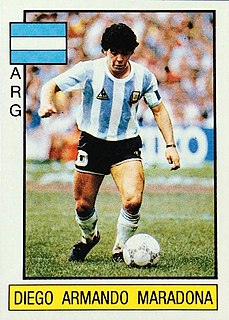 W
WA trading card is a small card, usually made out of paperboard or thick paper, which usually contains an image of a certain person, place or thing and a short description of the picture, along with other text. There is a wide variation of different types of cards. Modern cards even go as far as to include swatches of game-worn memorabilia, autographs, and even DNA hair samples of their subjects.
 W
WBowman Gum, formerly Gum Inc., had produced the 'Play Ball' sets from 1939 to 1941. No further sports trading card sets were produced until 1948 because resources such as paper as well as the factories were needed for the war effort. When Bowman resumed printing cards they did so with national sets in three sports ushering in the modern era of trading cards. The following is a list with brief summary of Bowman trading card products for the 1940s.
 W
WThe 1940s was both the beginning and end of an era for trading cards. There was virtually nothing produced in the great divide caused by World War II. Up to 1941 manufacturers like Gum Inc. and Goudey, had raised the bar on the confection industry by leaving behind the tobacco age of marketing to adults and bringing forth the bubble gum age and marketing to children. Topps had been primarily a gum company but took up adding premiums to their products after the war. Their first sets featured various sizes and numerous topics, mostly non-sport. The most notable is the Bazooka Gum comics although the earlier issues did not yet feature Joe and his gang. Below are descriptions of Topps products that were issued in the 1940s.
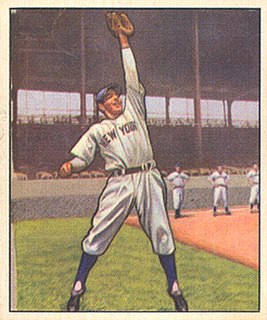 W
WIn the 1950s, Bowman Gum Company produced baseball and football cards from 1950 to 1955, continuing their post-war production that resumed in 1948. Bowman was the only major sports card manufacturer in 1950. The monopoly was short lived, as Topps Chewing Gum began producing cards in 1951. The rivalry lasted five years, punctuated by disputes over exclusive contracts with players. In 1956, faced with diminishing profits due to legal fees and increasing production costs, Bowman was bought out by Topps in 1956 for $200,000. The following provides a brief summary of trading card sets issued during the 1950s by Bowman.
 W
WThe company Topps joined the sports cards market in the 1950s becoming a rival to Bowman. After competing with each other for five years Topps bought out Bowman in 1956. Competition still remained however, in the form of Parkhurst hockey cards. Topps produced cards of the United States-based National Hockey League teams while Parkhurst covered the Canadian teams. Topps had produced multi-sport photo cards prior to 1950, namely the 1948 Topps Magic Photos but each set was very small and not considered a major set. This trend was consistent with their first baseball and college football issues: the 1950 Feltbacks resembled college pennants; 1951 Magic football included a scratch-off game on the reverse; Red/Blue Backs intended to be a card game; Connie Mack/Current All-Stars are foldable stand-ups. It was in 1952 that Topps released their first truly major card set. In the autumn of 1951, Woody Gelman and Sy Berger, then a 28-year-old veteran of World War II, designed the 1952 Topps baseball card set on the kitchen table of Berger's apartment on Alabama Avenue in Brooklyn. The 1957 Topps set featured dimensions of 2½ by 3½ inches which has become known as the standard card size. Below is a list with brief descriptions of Topps trading card products for the 1950s.
 W
WDespite a brief attempt by Fleer to sign baseball players in 1963, Topps continued its reign as the only major baseball card manufacturer in the United States. On the other hand, Football had more than one professional league in operation, allowing for competing companies to co-exist by producing a major national set for each league. Topps was able to produce National Football League sets from 1960 to 1963 while Fleer issued American Football League sets. Topps then began producing AFL sets from 1964 to 1967 while Philadelphia Gum issued NFL sets. Before the end of the decade Topps revived their basketball issue after a ten-year hiatus. The following is a list with brief descriptions of Topps sports card products for the 1960s. All cards listed are standard size(2½ × 3½ inches). Exceptions are noted.
 W
WThe 1970s saw Topps go largely uncontested in the sports card market. The decade featured full runs of baseball, football, basketball, and hockey. Aside from issues like Kellogg's cereal premiums which ran throughout the 70s there was not much in the way of major national card manufacturers to compete with. Topps maintained its license agreement with O-Pee-Chee in baseball and hockey. The company would have significantly more ground to cover given the growth of the professional sports leagues during the decade. Major League Baseball added four new teams in 1969 and two in 1977; the National Football League added two teams in 1976; the National Basketball Association gained three in 1970, one in 1974, and the American Basketball Association picked up one in 1972; the National Hockey League acquired two teams in each of 1970, 1972, and 1974. Soccer also made the Topps roster in the 70s, producing English and Scottish 'Footballers' for distribution in the United Kingdom. Domestic soccer was not to be forgotten with a North American Soccer League sticker set in 1979. The following are trading card sets issued by Topps in the 1970s. All cards listed are standard size. Exceptions are noted.
 W
WThis a list with brief descriptions of Topps trading card products for 1981. All sets listed are standard size unless noted.
 W
WThis a list with brief descriptions of Topps trading card products for 1982. All sets listed are standard size unless noted.
 W
WThis a list with brief descriptions of Topps trading card products for 1983. All sets listed are standard size unless noted.
 W
WThis a list with brief descriptions of Topps trading card products for 1984. All sets listed are standard size unless noted.
 W
WThis a list with brief descriptions of Topps trading card products for 1985. All sets listed are standard size unless noted.
 W
WThis a list with brief descriptions of Topps trading card products for 1986. All sets listed are standard size unless noted.
 W
WThis a list with brief descriptions of Topps trading card products for 1987. All sets listed are standard size unless noted.
 W
WThis a list with brief descriptions of Topps trading card products for 1988. All sets listed are standard size unless noted.
 W
WThis a list with brief descriptions of Topps trading card products for 1989. All sets listed are standard size unless noted.
 W
WThis a list with brief descriptions of Topps trading card products for 1990. All sets listed are standard size unless noted.
 W
WThis a list with brief descriptions of Topps trading card products for 1991. All cards listed are standard size. Exceptions are noted.
 W
WThis a list with brief descriptions of Topps trading card products for 1992. All cards listed are standard size. Exceptions are noted.
 W
WThe American Card Catalog: The Standard Guide on All Collected Cards and Their Values is a reference book for American trading cards produced before 1951, compiled by Jefferson Burdick. Some collectors regard the book as the most important in the history of collectible cards.
 W
WAn American football card is a type of collectible trading card typically printed on paper stock or card stock that features one or more American football players or other related sports figures. These cards are most often found in the United States and other countries where the sport is popular.
 W
WAn association football trading card is a type of trading card relating to association football, usually printed on cardboard, silk, or plastic. These cards feature one or more players, clubs, stadiums, or trophies. Football cards are most often found in Europe, Asia and South America.
 W
WAn Australian rules football card is a type of trading card relating to Australian rules football, usually printed on cardboard, silk, or plastic. These cards feature one or more Australian rules football players. Cards are almost exclusively found in Australia as no top-level leagues are present outside the country. Prices for Australian rules football cards can be very high. This is illustrated for both vintage and modern cards such as an 1894 American Tobacco Company card featuring Essendon player Will Crebbin which sold for $10,110 in 2018 and a 2004 Select AFL Conquest Triple Brownlow Medallist signature card featuring Nathan Buckley, Adam Goodes and Mark Ricciuto which was valued at $3,000 in 2018.
 W
WA baseball card is a type of trading card relating to baseball, usually printed on cardboard, silk, or plastic. In the 1970s they came with a stick of gum and a limited number of cards. These cards feature one or more baseball players, teams, stadiums, or celebrities. Baseball cards are most often found in the U.S. mainland but are also common in Puerto Rico or countries such as Canada, Cuba and Japan, where top-level leagues are present with a substantial fan base to support them. Some notable baseball card producing companies include Topps, Upper Deck Company, and Panini Group. Previous manufacturers include Fleer, Bowman, and Donruss. Baseball card production peaked in the late 1980s and many collectors left the hobby disenchanted after the 1994-95 MLB strike. However, baseball cards are still one of the most influential collectibles of all time. A T206 Honus Wagner was sold for $2.8 million in 2007.
 W
WBaseball Hobby News was a United States-based news-oriented magazine about the field of baseball memorabilia collecting. Founded in 1979 by the husband-and-wife team of Frank and Vivian Barning, who served as editor and publisher, respectively, the magazine was published on a monthly basis until 1993.
 W
WBaseball Talk was a set of 164 "talking" baseball cards that were released by Topps and the LJN Corporation during the spring of 1989. Each card featured a plastic disk affixed to the back of an oversized baseball card. When placed in the SportsTalk player the cards would play two to three minutes of recorded audio. The player retailed for $24.99 and was labeled for ages six and up. It required four AA alkaline batteries to operate.
 W
WA basketball card is a type of trading card relating to basketball, usually printed on cardboard, silk, or plastic. These cards feature one or more players of the National Basketball Association, National Collegiate Athletic Association, Olympic basketball, Women's National Basketball Association, Women's Professional Basketball League, or some other basketball related theme.
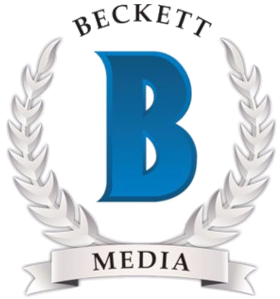 W
WBeckett Media is a media company that specializes in coverage of sports card and sports memorabilia markets. The company was founded in 1984 by James Beckett as Beckett Publications.
 W
WCard binders and 9-pocket pages are devices used to protect trading cards or game cards from damage and to store them. Card binders typically use a 3-ring binder or a D-ring binder.
 W
WPlastic card sleeves are devices used to protect trading cards, game cards, and collectible card game cards from wear and tear. The sleeves are an outer sheath of plastic into which a card is inserted.
 W
WCivil War News was a set of collectible trading cards issued in the early 1960s by Topps. The set featured colorful painted artwork and was characterized by vivid colors, graphic depictions of violence, death and blood and exaggerations of warfare, in a similar tone to the 1938 Gum Inc.'s Horrors of War, which was equally popular.
 W
WDinosaurs Attack! is a trading card series by Topps, released in 1988, and containing 55 base cards and 11 sticker cards. The cards tell the story of dinosaurs transported through time into the present day through a freak accident and wreaking havoc on Earth. The series is notable for its graphic violence and gore, intended to evoke memories of the successful Mars Attacks trading card series of 1962.
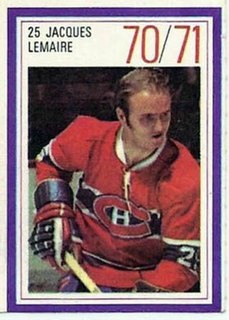 W
WNHL Power Players was a hockey trading card scheme dreamed up by Imperial Oil and the NHL Players' Association (NHLPA) in the 1970–71 hockey season.
 W
WFamous Game Designer Trading Cards are a series of trading cards first published by Flying Buffalo in 1992 that feature well-known game designers.
 W
WAn American football card is a type of collectible trading card typically printed on paper stock or card stock that features one or more American football players or other related sports figures. These cards are most often found in the United States and other countries where the sport is popular.
 W
WFutera is a trading card publisher founded in 1989. It is a privately owned company, its main markets being Asia, Europe, Australasia, US, with commercial and operational bases located in SE Asia, print and distribution facilities in UK/Europe and Asia-wide, and its headquarters in Dubai.
 W
WGarbage Pail Kids is a series of sticker trading cards produced by the Topps Company, originally released in 1985 and designed to parody the Cabbage Patch Kids dolls, which were popular at the time.
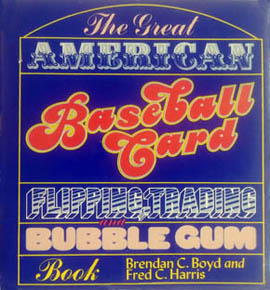 W
WThe Great American Baseball Card Flipping, Trading and Bubble Gum Book is a book written by Brendan C. Boyd & Fred C. Harris about baseball cards, primarily ones issued during the 1950s and 1960s, and the players on the cards.
 W
WA hockey card is a type of trading card typically printed on some sort of card stock, featuring one or more ice hockey players or other hockey-related editorial and are typically found in countries such as Canada, the United States, Finland and Sweden where hockey is a popular sport and there are professional leagues. The obverse side normally features an image of the subject with identifying information such as name and team. The reverse can feature statistics, biographical information, or as many early cards did, advertising. There is no fixed size or shape of hockey cards, running the gamut from rectangular to circular, however modern North American cards have typically standardized on a 2.5 by 3.5 inch rectangular format.
 W
WHollywood Zombies was a trading card series manufactured by Topps, which portrayed American celebrities at the time as flesh-eating zombies. Released in 2007, the series was available only in select comic book specialty shops and video stores.
 W
WThis is a list of the highest known prices paid for sports cards. The current record price is the US$3.936 million paid for the one-of-one Mike Trout 2009 Bowman Chrome Draft Prospects Superfractor Autograph in August 2020.
 W
WMars Attacks is a science fiction-themed trading card series released in 1962 by Topps. The cards feature artwork by science fiction artists Wally Wood and Norman Saunders. The cards form a story arc, which tell of the invasion of Earth by cruel, hideous Martians, under the command of a corrupt Martian government who conceal the fact from the Martian populace that Mars is doomed to explode and therefore proposes a colonization of Earth to turn it into their new homeworld. The cards depict futuristic battle scenes and bizarre methods of Martian attack, torture and slaughter of humans, as well as various Earth nations being attacked. The story concludes with an expeditionary force of humans volunteering to embark on a counterattack on Mars, in which the Earth force attacks the Martians in their manner. This necessitates the Martians that are still on Mars to defend their homeworld. The Earth attack forces, after destroying the Martian cities and killing the Martians, depart just before Mars is destroyed in the predicted cataclysm, thus ensuring the peace and safety of Earth as the Martian race is seemingly doomed to extinction.
 W
WMonsterwax is a trading card company that specializes in science fiction and horror themes. It was established in 1992, making it the oldest American card company still in business exclusively producing non-sports trading card sets. Many trading card companies like Topps are corporate subsidiaries that primarily produce sports related issues. However, Monsterwax is a small privately owned company focusing primarily on non-licensed entertainment cards. They usually release only one to three series a year. Monsterwax generally limits their print runs to less than 500 boxes and numbers each box and checklist.
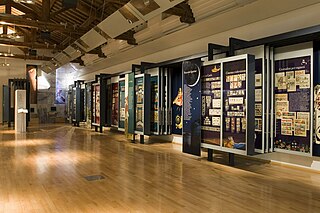 W
WThe Museo della figurina is a museum dedicated to collectible cards. Opened on December 15, 2006, it is located inside Palazzo Santa Margherita, in Modena, Italy.
 W
WNon-sport trading cards are a particular kind of collectible card designated as such because trading cards have historically prominently featured athletes from the world of sports as subjects. Non-sports cards are trading cards whose subjects can be virtually anything other than sports-themed.
 W
WPro Set was a Dallas-based trading card company founded by Ludwell Denny in 1988. Denny had gained a card license that year after making and selling other NFL memorabilia in previous years. His licensing agreement with NFL Properties allowed Denny to gain access to its extensive photo library and become the first card maker officially associated with a professional sports league. Across the bottom of most of his company's cards was its designation as "The Official NFL Card," a distinction it held through 1991.
 W
WA Rugby card is a type of trading card relating to Rugby football, usually printed on cardboard, silk, or plastic. These cards are most often found in the Australia, New Zealand and other countries where the sport is popular.
 W
WNorman Blaine Saunders was a prolific 20th-century American commercial artist. He is best known for paintings in pulp magazines, paperbacks, men's adventure magazines, comic books and trading cards. On occasion, Saunders signed his work with his middle name, Blaine.
 W
WA spoke card, or spokecard, is a card placed in the spokes of a bicycle wheel. They lie parallel to the entire wheel. Most spoke cards are laminated.
 W
WStar Wars trading card usually refers to a non-sport card themed after a Star Wars movie or television show. However a common colloquial reference to trading card can also include reference to stickers, wrappers, or caps (pog) often produced along the same theme. Usually produced as either promotional or collectible memorabilia relating to Star Wars, the cards can depict anything from screen still imagery to original art. In addition, there have been various companies that have issued promotional Star Wars trading cards that include reference to or information about that corresponding company.
 W
WSteam Trading Cards are a digital commodity issued by Valve for use on its digital distribution platform, Steam. Steam Trading Cards are a non-physical analogue of conventional trading cards, which are periodically granted to Steam users for playing games, fulfilling tasks, or by random chance. Cards can be "crafted" to acquire Steam-centric awards such as emoticons or profile backgrounds, traded to other Steam users, or sold through the Steam Community Market for store credit.
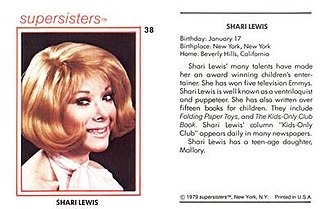 W
WSupersisters was a set of 72 trading cards produced and distributed in the United States in 1979 by Supersisters, Inc. They featured famous women from politics, media and entertainment, culture, sports, and other areas of achievement. The cards were designed in response to the trading cards popular among children in the US at the time which mostly featured men.
 W
WThe T205 was a baseball card set issued in 1911 by the American Tobacco Company through 11 different cigarette brands owned by it. The collection is considered a landmark set in the history of baseball card collecting.
 W
WT206 was a tobacco card set issued from 1909 to 1911 in cigarette and loose tobacco packs through 16 different brands owned by the American Tobacco Company. It is a landmark set in the history of baseball card collecting, due to its size and rarity, and the quality of its color lithographs. Several of the cards are among the most expensive sports cards ever sold.
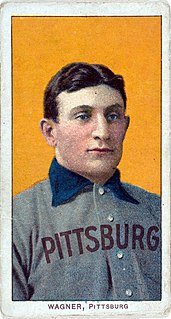 W
WThe T206 Honus Wagner baseball card depicts the Pittsburgh Pirates' Honus Wagner, a dead-ball era baseball player who is widely considered to be one of the best players of all time. The card was designed and issued by the American Tobacco Company (ATC) from 1909 to 1911 as part of its T206 series. Wagner refused to allow production of his baseball card to continue, either because he did not want children to buy cigarette packs to get his card, or because he wanted more compensation from the ATC. The ATC ended production of the Wagner card and a total of only 50 to 200 cards were ever distributed to the public, as compared to the "tens or hundreds of thousands" of T206 cards, over three years in sixteen brands of cigarettes, for any other player. In 1933, the card was first listed at a price value of US$50 in Jefferson Burdick's The American Card Catalog, making it the most expensive baseball card in the world at the time.
 W
WT213 was a baseball card set issued between 1910 and 1919 by tobacco manufacturer Coupon Cigarettes, based in New Orleans.
 W
WThe Topps Company has created a number of different baseball card products during its existence. They originally started as a chewing gum company, using the baseball cards as a sales gimmick to make the gum more popular, but, it somehow turned into a huge company making money and creating new sets to keep customers buying from their company. Topps has used a number of brand names and distribution methods to cater to various segments of the market.
 W
WWacky Packages are a series of humorous trading cards featuring parodies of consumer products. The cards were produced by Topps beginning in 1967, usually in a sticker format. There were 16 series produced between 1967 and 1976, with some reprints and new series released up to the present day.